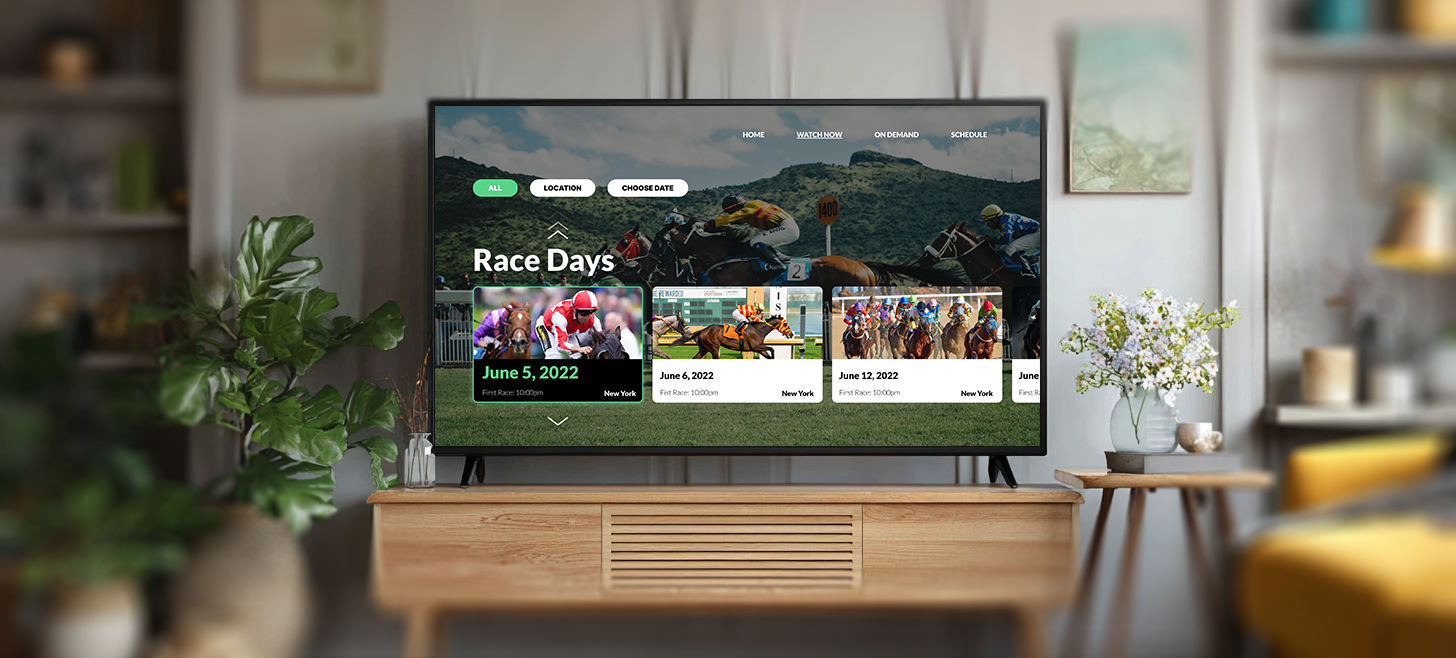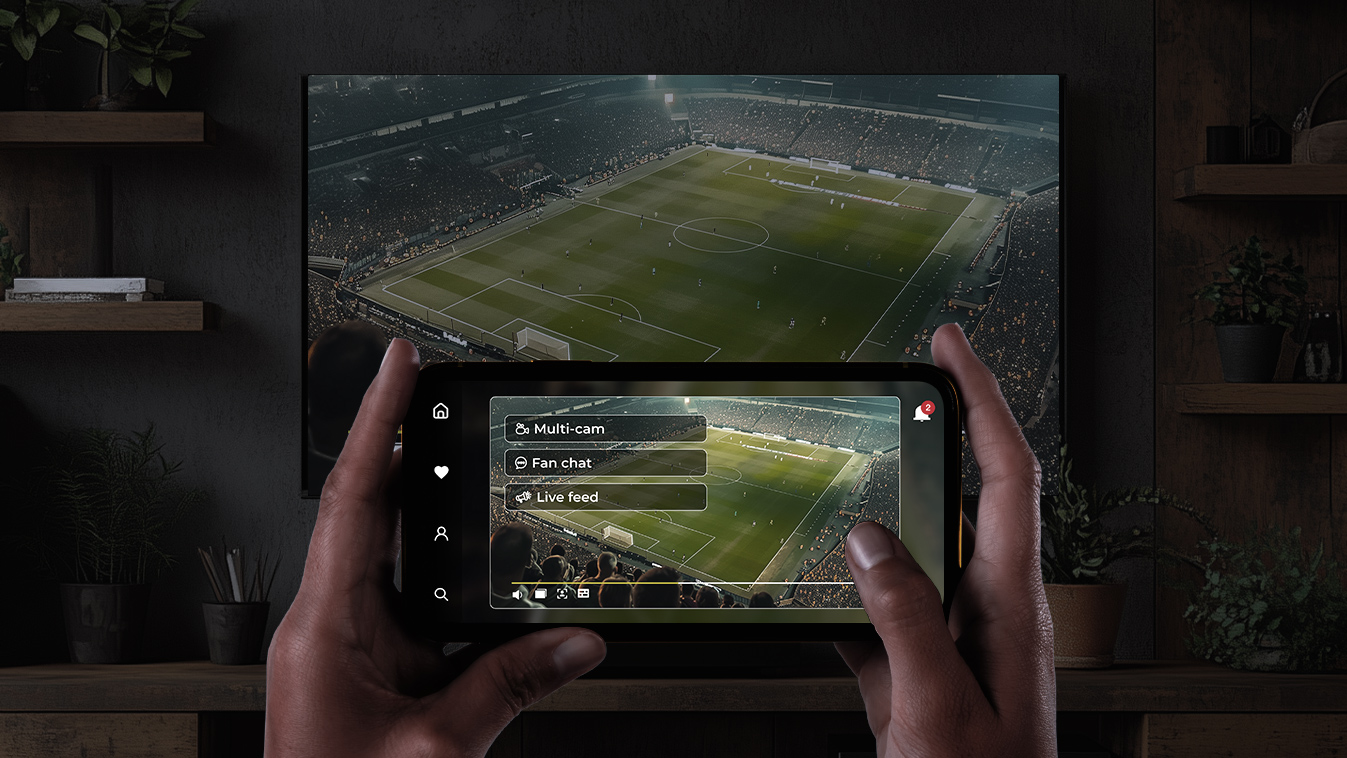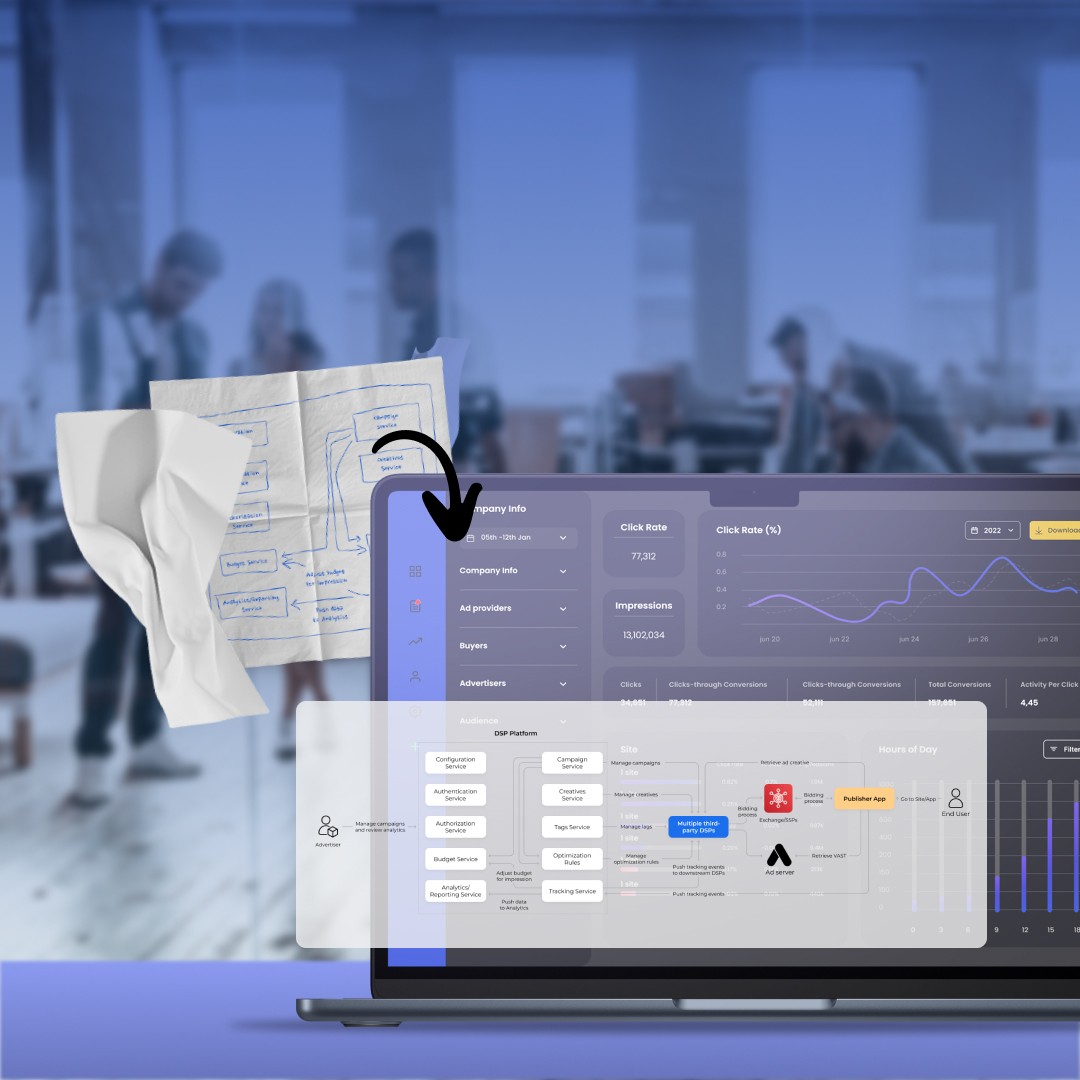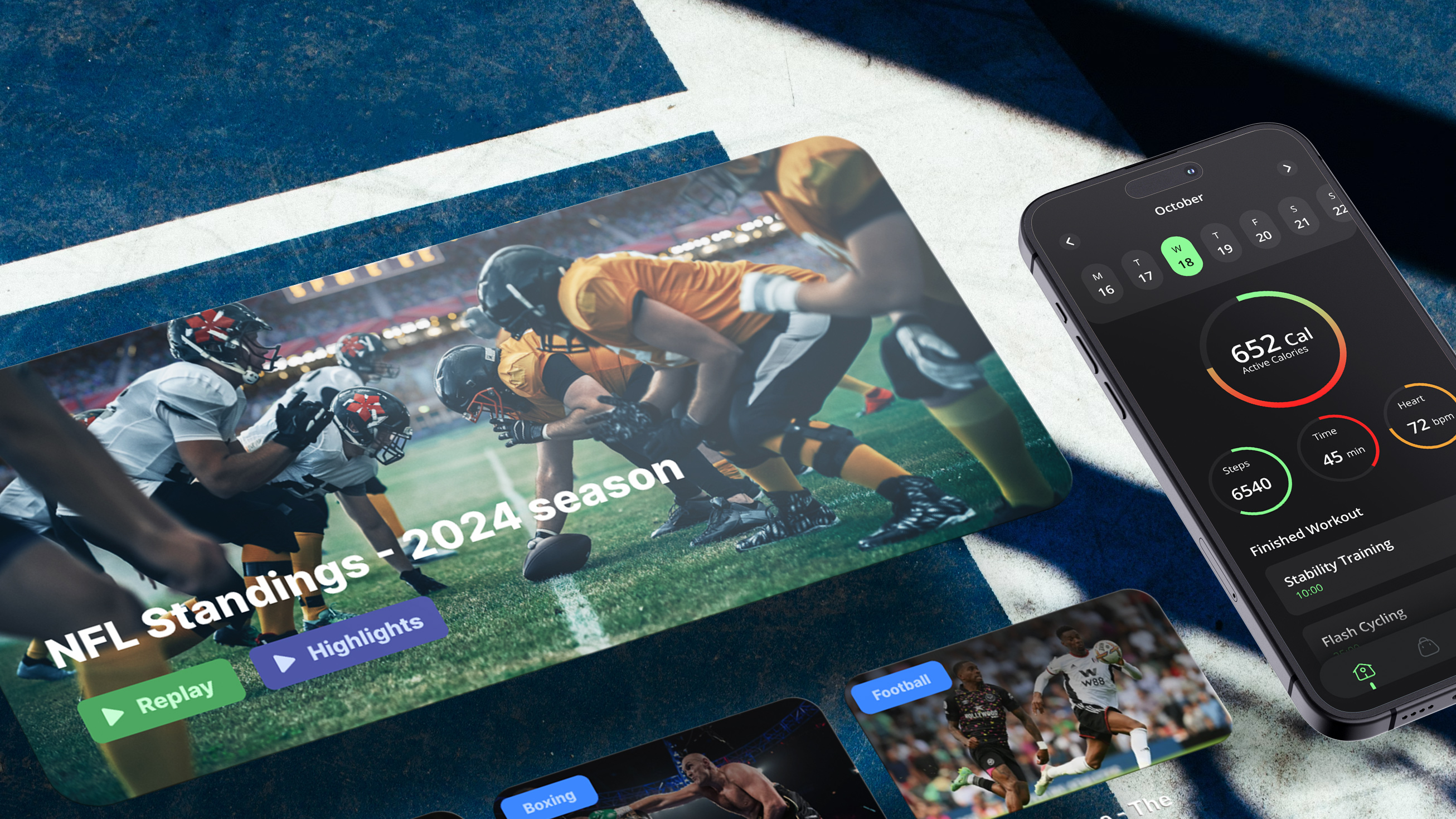Live streaming technology has become a common way to watch sports and events, but delivering smooth, real-time video experiences requires a lot of technical work behind the scenes.
In this article, we’ll explain the main components that make live video streaming possible — from compressing and encoding video to distributing it globally through Content Delivery Networks. We’ll also cover why a reliable infrastructure is essential and how interactive features can help keep viewers engaged, especially during live sports broadcasts. Finally, we’ll discuss how effective live streaming app development practices can boost revenue and why partnering with an experienced tech provider matters.
Technologies behind live streaming

Behind every successful live sports broadcast is a complex, well-orchestrated technology stack working tirelessly to keep viewers engaged. Here’s a breakdown of the key components that make live video streaming possible, and why each step matters.
Compression
Live video needs compression primarily to reduce the enormous amount of raw video data into a smaller size that can be efficiently transmitted over networks with limited bandwidth. Raw video streams are extremely large; for example, even low-resolution video can require gigabits per second, far exceeding common network capacities.
The data is compressed by removing redundant visual information. For instance, if the first frame shows a player running across the field against a static background, that background doesn’t need to be re-encoded for every subsequent frame unless it changes.
Encoding
Once compressed, video needs to be encoded into a digital format suitable for transmission. Encoding is essential for converting visual information into data that streaming platforms and end-user devices can understand and process.
This is typically done using codecs such as H.264 or H.265, which balance compression efficiency and quality. The encoder takes the compressed video frames and transforms them into a continuous stream of binary data, ready to be broken into smaller segments for delivery.
Segmentation
Segmentation breaks the encoded video stream into smaller, manageable chunks — usually ranging from 2 to 10 seconds in length. This step is crucial for enabling adaptive bitrate streaming, improving playback stability, and reducing latency.
Each segment can be requested and loaded independently by the player. This means if a viewer’s internet slows down, the player can quickly switch to a lower-quality segment without interrupting playback.
Content delivery network (CDN) distribution
A single server can’t handle the massive demand of thousands or millions of simultaneous live stream viewers. That’s where CDN distribution comes in. A CDN is a global network of strategically placed servers that distribute streaming content closer to the end-users.
Once a live stream is segmented, it’s pushed to multiple CDN nodes across various regions. This helps reduce buffering, improves load times, and prevents server overload during peak traffic moments — like a last-minute goal in a championship match.
CDN caching
Caching within a CDN ensures that popular video segments don’t have to be re-fetched from the origin server every time a new viewer joins. This is especially critical for live sports, where thousands of viewers may be watching the same feed simultaneously.
When a user requests a segment, the CDN checks if it’s already stored locally. If it is, the segment is delivered instantly; if not, it’s fetched from a higher-tier node or the origin, then cached for future viewers. This reduces latency and conserves bandwidth.
Decoding
On the viewer’s side, decoding is what transforms the incoming encoded video data back into visual content that can be displayed on the screen. Without decoding, the stream would be unreadable gibberish to the device.
Decoders — built into web browsers, smart TVs, and mobile apps — take the encoded binary stream, reverse the encoding process, and reconstruct the compressed frames for playback. Efficient decoding is key to maintaining smooth visuals, especially on lower-power devices.
Video playback
Finally, playback stitches all the pieces together and presents the video in real time. The player must handle segment switching, buffering, rendering, and user interaction (like pausing or changing resolution).
A good video player adapts to changing network conditions, recovers from stalls, and ensures that the live stream stays as close to real time as possible — often with just a few seconds of delay from the source camera to the user’s screen.
Now that we’ve broken down the key components powering live streaming, let’s shift focus to what really matters to your audience — a reliable, smooth, and engaging viewing experience. The truth is, even the best technology stack won’t guarantee success unless it’s set up and managed with the right practices in mind. In the next section, we’ll share actionable tips that help B2B platforms deliver top-quality streams every time.
Your stream is only as strong as your infrastructure
Even the most thrilling sports match or live concert won’t hold viewers’ attention if the stream lags, buffers, or cuts out. To avoid frustration and ensure every broadcast meets professional expectations, media platforms need more than just the right tools — they need a clear strategy for optimizing their live streaming infrastructure. Let’s look at the best practices that make it possible.
Lag and buffering
Delays and pauses during a live stream are the fastest way to lose viewers. In sports, where every second matters, lag kills excitement and trust.
While some interruptions depend on the viewer’s connection, broadcasters must deliver consistent low-latency playback across devices. Adaptive bitrate streaming, ultra-low-latency protocols like LL-HLS or WebRTC, and smart segment preloading help keep playback smooth and responsive.
Interrupted broadcasts
Unexpected crashes during a stream — especially at peak moments — can ruin the viewer experience and damage your brand. These failures often happen when infrastructure can’t scale fast enough to handle traffic spikes.
Broadcasters need elastic server capacity, CDN load balancing, and automatic scaling to handle surging viewership without breaking the stream. In a competitive market, stream stability directly impacts viewer retention and monetization.
Case in point: scalable streaming with stable performance — the solution built in 2.5 months
To deliver both live and on-demand horse racing content, Oxagile developed a multi-platform streaming solution optimized for Roku, Apple TV, and Amazon Fire TV — delivered on a tight schedule.

Protect your live streams
Delivering content is only half the job — protecting it is the other half.
To secure your streams, use firewalls, SSL encryption, and geo-blocking controls. Prevent piracy with strong DRM and watermark your streams during playback to track unauthorized use. A secure stream protects revenue and your reputation.
Creating an engaging viewing experience for fans during live sports matches
Live sports are among the most demanding types of content to stream. Millions of viewers tune in simultaneously, expecting flawless quality and real-time action with zero delays. Unlike other live events, even a few seconds of lag or buffering can ruin the experience — imagine seeing a goal notification on social media before watching it on your screen. That’s why sports streaming sets a particularly high bar for reliability and engagement.
In sports live streaming, distributors must balance classic technical requirements — such as smooth, uninterrupted streaming and minimal latency — with the growing trend of making live sports matches more engaging. The goal is to deliver a viewing experience that makes fans feel as if they are right in the stadium.
Still, both technical excellence and fan engagement equally matter. Buffering or lag can quickly frustrate online fans, while lack of interactivity can reduce their emotional connection to the event.
To create this immersive experience with live sports streaming technology, you may use a variety of strategies to keep your viewers immersed during live matches:
- AI-powered highlights
Fans may need to relive the most exciting parts of a match, especially if they missed the live broadcast or know the outcome. Advanced AI solutions can automatically identify key moments — goals, fouls, important plays — and generate personalized highlight reels to keep fans engaged.

- Interactive features timed for maximum impact
Real-time polls, score predictions, and quizzes allow fans to participate actively without distracting from the live action. These features are usually introduced during breaks or through companion devices, ensuring the main stream remains the focus.

- Second-screen experiences on companion devices
Many fans use smartphones during live matches for chatting, social media, or even ordering food. Leveraging this behavior, you may offer multi-camera views, live stats, fan chats, and social feeds on second screens, enhancing engagement without interrupting the main stream.

- Building community and loyalty through AI and social interaction
Dynamic player focus, detailed player stats on demand, and private chat rooms during live streams help fans feel connected and deepen their loyalty.

In short, successful sports live streaming requires seamless integration of flawless streaming technology and thoughtful fan engagement features. This combination helps create a viewing experience that truly immerses fans, making them feel part of the live stadium atmosphere.
Effective live sports streaming solutions for better fan experience
Custom platforms delivering smooth, reliable broadcasts and interactive viewing across any device. Start enhancing your live streams today.
Maximizing revenue with live streaming
Live video streaming technology opens up new opportunities for content distributors to increase revenue and engage their audience in real time.
If you already offer live broadcasts, it’s a good time to explore fresh strategies for keeping viewers hooked. Using interactive features — like live polls, chats, or real-time stats — and other engagement tools can significantly boost viewer loyalty and time spent watching.
If your platform mainly focuses on video-on-demand, adding live streams can diversify your content offerings and attract new audiences. Keep in mind, however, that live streaming comes with its own set of technical and user experience challenges that need careful planning and execution.
In both cases, working with a trusted technology partner such as Oxagile can make a big difference. With experience in custom live streaming solutions, we help you implement the right features, ensure smooth delivery, and support you every step of the way.






























